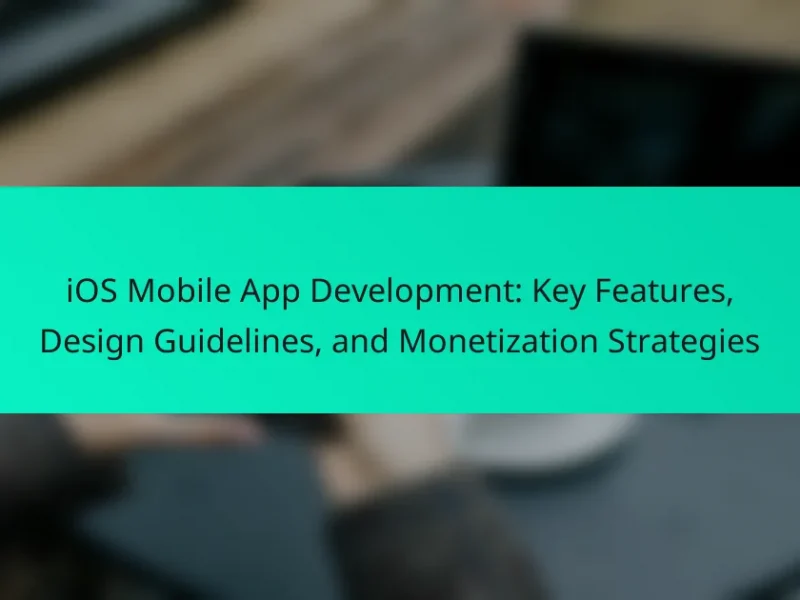Mobile app development is rapidly evolving, driven by trends such as artificial intelligence (AI), augmented reality (AR), and cross-platform development. AI enhances user experiences through personalization, while AR is gaining traction in gaming and retail sectors. Cross-platform development facilitates quicker deployment across various operating systems, and cloud integration supports seamless data access. Additionally, the increasing focus on app security addresses rising cyber threats, and the adoption of 5G technology is improving app performance. Developers must adapt to these trends to meet user expectations and market demands, prioritizing faster development cycles, robust security measures, and the integration of emerging technologies. Future trends indicate a growing reliance on AI, machine learning, and low-code development, alongside a heightened emphasis on sustainability in app design.

What are the current trends in mobile app development?
Current trends in mobile app development include the rise of artificial intelligence, augmented reality, and cross-platform development. Artificial intelligence enhances user experience through personalized recommendations. Augmented reality applications are increasingly popular in gaming and retail. Cross-platform development allows for faster deployment across multiple operating systems. Cloud integration is also a key trend, enabling seamless data access and storage. Additionally, the focus on app security is intensifying due to rising cyber threats. The use of 5G technology is improving app performance and enabling new functionalities. These trends reflect the evolving needs and preferences of users in the mobile app market.
How are emerging technologies shaping mobile app development?
Emerging technologies are significantly shaping mobile app development by enhancing functionality and user experience. Technologies like artificial intelligence (AI) enable personalized app interactions. Machine learning algorithms analyze user behavior to provide tailored content. Augmented reality (AR) and virtual reality (VR) create immersive experiences in gaming and retail apps. The Internet of Things (IoT) allows apps to connect with smart devices for seamless control. Cloud computing enhances app scalability and storage capabilities. According to a report by Statista, the global cloud application market is projected to reach $1 trillion by 2025. Blockchain technology is improving security and transparency in transactions. These advancements lead to more innovative and efficient mobile applications.
What role does artificial intelligence play in mobile app development?
Artificial intelligence significantly enhances mobile app development. It streamlines processes like coding, testing, and user experience design. AI algorithms can analyze user behavior to personalize app content. Machine learning models improve app functionality by predicting user needs. Natural language processing enables voice commands and chatbots within apps. AI also automates testing, reducing time and costs. According to a report by Gartner, AI will be a key driver in 70% of new app development by 2025. This demonstrates AI’s integral role in shaping the future of mobile applications.
How is augmented reality being integrated into mobile applications?
Augmented reality is being integrated into mobile applications through various technologies and frameworks. Developers utilize ARKit for iOS and ARCore for Android to create immersive experiences. These tools allow for real-time environment mapping and object recognition. Applications in retail enable users to visualize products in their own space. Education apps use AR to enhance learning through interactive 3D models. Gaming apps incorporate AR to blend virtual elements with the real world. Social media platforms integrate AR filters for enhanced user engagement. The global AR market is projected to reach $198 billion by 2025, indicating a growing trend in mobile app integration.
What user preferences are influencing mobile app trends?
User preferences influencing mobile app trends include personalization, ease of use, and performance. Personalization allows users to tailor their experiences, making apps more engaging. Ease of use is essential for user retention; apps must be intuitive and user-friendly. Performance is critical, with users expecting fast load times and smooth interactions. According to a survey by Statista, 89% of users prefer apps that load quickly. Additionally, security and privacy concerns are increasingly important, with users favoring apps that protect their data.
How do user experience and design impact app success?
User experience and design significantly impact app success by influencing user satisfaction and retention. A well-designed app enhances usability, making it easier for users to navigate and accomplish tasks. Positive user experiences lead to higher engagement rates. Research shows that 88% of online consumers are less likely to return to a site after a bad experience. Furthermore, aesthetically pleasing design can create a strong first impression, encouraging downloads. According to a study by Google, 61% of users are unlikely to return to a mobile site if they had trouble accessing it. Thus, prioritizing user experience and design is crucial for achieving app success.
What features are users demanding in mobile applications?
Users are demanding several key features in mobile applications. These include user-friendly interfaces that enhance navigation. Performance and speed are critical, with users preferring fast-loading apps. Customization options allow users to tailor their experience. Security features are increasingly important, especially for personal data protection. Integration with other apps and services enhances functionality. Offline access is a desirable feature for uninterrupted use. Regular updates and bug fixes are expected to maintain app performance. Finally, support for multiple languages broadens user accessibility.
How are market demands driving mobile app development strategies?
Market demands are significantly influencing mobile app development strategies. Developers prioritize user experience to meet evolving consumer expectations. The rise of on-demand services has increased the demand for apps that provide instant solutions. Data shows that 70% of users abandon apps due to poor performance. This drives developers to focus on speed and reliability in their applications. Additionally, the popularity of mobile commerce has led to a surge in e-commerce app development. Research indicates that mobile commerce sales are projected to exceed $3.5 trillion by 2021. As a result, developers integrate advanced features like secure payment gateways. Furthermore, the demand for personalization is pushing developers to leverage AI and machine learning. These technologies allow for tailored user experiences based on individual preferences. Overall, market demands are shaping a more user-centric approach in mobile app development.
What industries are experiencing the highest demand for mobile apps?
The industries experiencing the highest demand for mobile apps include healthcare, retail, finance, and education. Healthcare apps are in demand for telemedicine and patient management. Retail apps enhance customer engagement and streamline shopping experiences. Finance apps provide mobile banking and investment services. Education apps facilitate online learning and tutoring. According to Statista, the mobile app market is projected to reach $407.31 billion by 2026, highlighting the growing need across these sectors.
How do market trends affect app monetization strategies?
Market trends significantly influence app monetization strategies. As user preferences shift, developers adapt their monetization approaches. For instance, the rise of subscription models reflects a trend toward sustainable revenue streams. According to Statista, subscription apps generated over $13 billion in revenue in 2021. Additionally, increased competition drives developers to innovate monetization tactics. Trends like in-app purchases and ad-based revenue models are becoming prevalent. Market analysis shows that user engagement directly impacts monetization success. Apps that align with current trends often see higher user retention and revenue growth. Thus, market trends are crucial in shaping effective app monetization strategies.

What are the implications of these trends for developers?
The implications of mobile app development trends for developers include the need to adapt to emerging technologies and changing user preferences. Developers must embrace technologies like artificial intelligence and augmented reality. These technologies enhance user experiences and engagement. Additionally, developers need to prioritize cross-platform compatibility. This is essential as users expect seamless functionality across devices.
Market demands also require developers to focus on faster development cycles. Agile methodologies are becoming increasingly important. They enable developers to respond quickly to user feedback and market changes. Furthermore, data privacy and security have become critical considerations. Developers must implement robust security measures to protect user data.
According to a report by Statista, 70% of users uninstall apps due to poor performance. This statistic highlights the importance of optimizing app performance. Overall, developers must stay informed about trends to remain competitive in the evolving mobile app landscape.
How can developers leverage emerging technologies in their apps?
Developers can leverage emerging technologies in their apps by integrating artificial intelligence, machine learning, and augmented reality. These technologies enhance user experience and improve app functionality. For instance, AI can provide personalized recommendations, increasing user engagement. Machine learning algorithms can analyze user data to optimize app performance. Augmented reality can create immersive experiences, particularly in gaming and retail apps. According to a report by Statista, the global AI market is expected to reach $126 billion by 2025, highlighting its growing importance. By adopting these technologies, developers can stay competitive and meet evolving user expectations.
What tools and frameworks are available for integrating AI and AR?
Tools and frameworks for integrating AI and AR include Unity, Vuforia, and TensorFlow. Unity is a popular game development platform that supports AR development through its AR Foundation toolkit. Vuforia provides a robust set of features for image recognition and tracking, facilitating AR experiences. TensorFlow offers machine learning capabilities that can enhance AI functionalities within AR applications. Other notable tools include ARKit and ARCore, which are designed for iOS and Android, respectively. These frameworks allow developers to create immersive experiences by combining AI-driven insights with augmented reality visuals.
What best practices should developers follow to meet user preferences?
Developers should prioritize user-centric design to meet user preferences effectively. This involves conducting thorough user research to understand needs and expectations. Gathering user feedback through surveys and usability testing is essential. Developers should also ensure their apps are intuitive and easy to navigate. Incorporating personalization features can enhance user satisfaction. Regular updates based on user feedback keep the app relevant. Furthermore, optimizing performance and ensuring quick load times are critical. Studies show that 53% of users abandon apps that take longer than three seconds to load.
How can user feedback be effectively incorporated into app design?
User feedback can be effectively incorporated into app design by implementing a structured feedback loop. This involves collecting user input through surveys, interviews, and usability testing. Analyzing this feedback helps identify pain points and areas for improvement. Prioritizing changes based on user needs ensures the design aligns with user expectations. Iterative design processes allow for continuous integration of feedback. Regular updates based on user suggestions can enhance satisfaction and engagement. Data from sources like the Nielsen Norman Group supports the effectiveness of user-centered design approaches.

What future trends should developers anticipate in mobile app development?
Developers should anticipate several future trends in mobile app development. Increased use of artificial intelligence and machine learning will enhance app functionality. Apps will become more personalized through advanced data analytics. The demand for cross-platform development tools will rise, enabling broader reach. Enhanced app security measures will become essential due to rising cybersecurity threats. Integration of augmented reality and virtual reality will create immersive user experiences. The trend toward low-code and no-code development will accelerate, allowing non-developers to create apps. Finally, the focus on sustainability in app design will grow, aligning with global environmental concerns.
How will advancements in technology impact future mobile applications?
Advancements in technology will significantly enhance future mobile applications. Improved hardware capabilities will allow for more complex and resource-intensive applications. For instance, faster processors and increased memory will enable smoother performance and multitasking. Artificial intelligence will facilitate personalized user experiences through intelligent algorithms. Augmented reality will transform how users interact with apps by overlaying digital information on the real world. Cloud computing will enable seamless data synchronization and storage, making apps more accessible across devices. Additionally, 5G technology will provide faster internet speeds, enhancing real-time functionalities. According to a report by Statista, the global mobile app market is projected to reach $407.31 billion by 2026, reflecting the growing impact of these advancements.
What potential changes in user behavior should developers prepare for?
Developers should prepare for increased demand for personalized user experiences. Users are increasingly expecting apps to adapt to their preferences and behaviors. This trend is driven by advancements in artificial intelligence and machine learning. Users are also shifting towards more privacy-conscious behavior. They are becoming more selective about data sharing and app permissions. Additionally, there is a growing preference for seamless cross-platform experiences. Users expect apps to function smoothly across different devices and operating systems. The rise of voice and gesture-based interactions is also notable. Users are gravitating towards hands-free and intuitive navigation methods. These changes are influenced by the widespread adoption of smart devices and IoT technology. Developers must adapt their strategies to meet these evolving user expectations.
What strategies can developers adopt to stay competitive in the market?
Developers can adopt several strategies to stay competitive in the market. Continuous learning and skill enhancement are crucial. This includes staying updated with emerging technologies such as AI and machine learning. Additionally, developers should focus on user experience design. A well-designed app can significantly improve user retention rates. Collaboration with cross-functional teams is also beneficial. This fosters innovation and enhances product quality. Emphasizing agile development practices allows for quicker adaptation to market changes. Furthermore, developers should engage with user feedback regularly. This helps in identifying areas for improvement and aligning with user preferences. Finally, leveraging data analytics can provide insights into user behavior, guiding future development efforts.
How can continuous learning and adaptation benefit mobile app developers?
Continuous learning and adaptation enhance the skills and knowledge of mobile app developers. This process allows developers to stay updated with the latest technologies and industry trends. For instance, the mobile app development landscape evolves rapidly, with new frameworks and programming languages emerging regularly. By engaging in continuous learning, developers can effectively incorporate these advancements into their projects.
Moreover, adaptation to user feedback and market demands leads to improved app functionality and user satisfaction. Research shows that apps that evolve based on user preferences achieve higher retention rates. According to a survey by Statista, 90% of users prefer apps that are regularly updated and improved. Therefore, continuous learning and adaptation ultimately lead to more successful and competitive mobile applications.
What are some practical tips for succeeding in mobile app development?
Focus on user experience. Prioritize intuitive design and seamless navigation. Conduct user research to understand needs. Utilize prototyping tools for feedback. Keep up with platform guidelines for Android and iOS. Optimize performance to enhance speed and responsiveness. Regularly update the app to fix bugs and add features. Leverage analytics to track user behavior and improve the app.
Mobile app development is evolving rapidly, influenced by emerging technologies, user preferences, and market demands. Key trends include the integration of artificial intelligence and augmented reality, which enhance user experiences and app functionality. Developers are increasingly focusing on cross-platform compatibility and app security to meet user expectations for performance and personalization. Additionally, industries such as healthcare, retail, and finance are driving demand for innovative mobile applications, while market trends are shaping monetization strategies and development practices. Overall, staying informed about these trends is crucial for developers to remain competitive in the mobile app landscape.


